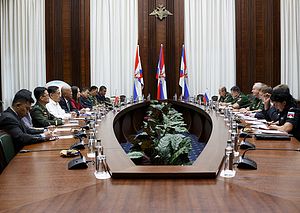Last week, Russia’s ambassador to the Philippines floated the idea of a joint military facility between the two countries. Though specifics remain unclear about the initiative, the idea nonetheless highlighted continuing inroads Moscow has been attempting to showcase within the broader bilateral defense relationship under Philippine President Rodrigo Duterte.
As I have observed previously in these pages and elsewhere, one of the consequences of Duterte’s so-called independent foreign policy since he took office in 2016 has been the diversification of ties that the Philippines, a traditional U.S. treaty ally, has with countries such as China and Russia. As this has occurred, we have seen the slow development of Russia-Philippines defense relations despite the challenges that still exist, including the inking of new defense pacts, visits by vessels on both sides, and the transfer of some military equipment and expertise to meet Manila’s needs.
Last week, the defense aspect of the relationship was in the spotlight again with remarks given by Russian Ambassador to the Philippines Igor Khovaev. In remarks to reporters about the future promise of bilateral defense ties, Khovaev said that Russia was ready to organize joint production of weapons in the Philippines.
Per Philippine media outlet Rappler, Khovaev told reporters during a briefing at his residence in Makati City that Russia’s proposal was to “organize joint production of Russian sophisticated light arms and small weapons here in the Philippines.” “You Filipinos will produce Russian arms and weapons…. They will be Philippine products based on Russian technologies,” he added regarding the proposal. He also noted that both governments had started “bilateral negotiations” on the plan which would also involve private partners, and that he hoped it would materialize “as soon as possible.”
Khovaev’s comments themselves are not surprising. Russia has repeatedly been highlighting the future prospects of increasing defense relations with the Philippines during Duterte’s time in office, and the joint production facility is just one of the manifestations of this. Indeed, during his briefing to reporters, Khovaev also mentioned several other aspects of potential defense collaboration, including acquisitions of submarines and helicopters, more joint military exercises, and enhanced education exchanges.
Yet it is unclear to what extent this idea will actually be realized. Khovaev was clear that this was an idea still being worked through, and offered few of the specifics that would be needed to determine the feasibility of such a facility, including timelines, cost, and potential location. And Philippine Defense Secretary Delfin Lorenzana told local media that while Russia may be ready for this proposal, the Philippines may not be, given the challenges in implementing it, including those regarding interoperability of equipment such as rifles.
To be sure, it is still early days with respect to this new proposal, and details remain to be worked out by both sides. Nonetheless, the idea of a joint production facility will continue to be important to watch amid other ongoing developments in defense ties, be it individual transfers of defense equipment or high-level developments such as Russian President Vladimir Putin’s potential visit to the Philippines.
































